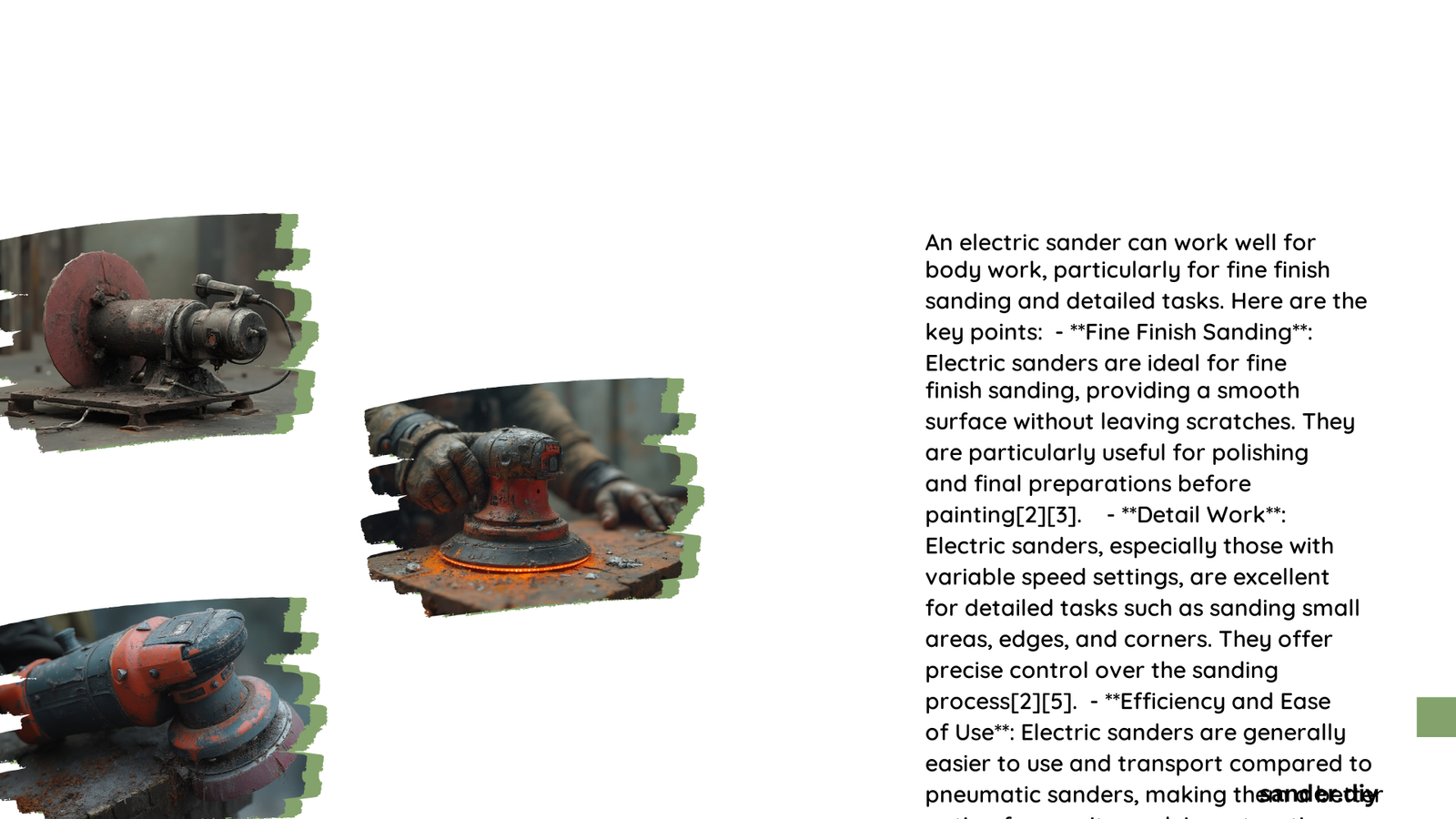Electric sanders are highly effective for auto body work, offering superior speed, consistency, and finish quality compared to manual sanding. They excel in removing old paint, smoothing body filler, and preparing surfaces for painting. With features like variable speed control, dust collection systems, and ergonomic designs, electric sanders significantly reduce work time and user fatigue. However, proper technique and grit selection are crucial for optimal results in automotive body work.
What Are the Best Electric Sanders for Auto Body Work?
When it comes to auto body work, certain electric sanders stand out for their performance and features:
- Makita BO5041K Random Orbit Sander
- Power: 3 Amps
- Speed: 4,000 – 12,000 OPM
-
Key Features: Variable speed, excellent dust collection, ergonomic design
-
BOSCH ROS20VSC Palm Sander
- Power: 2.5 Amps
- Speed: 7,500 – 12,000 OPM
-
Key Features: Compact, lightweight, variable speed control
-
DEWALT Random Orbit Sander
- Power: 3 Amps
- Speed: 8,000 – 12,000 OPM
- Key Features: Balanced design, variable speed, durable build
These sanders are preferred for their ability to provide smooth, swirl-free finishes and their effectiveness in various auto body tasks.
How Do Electric Sanders Compare to Manual Sanding for Body Work?

The comparison between electric and manual sanding reveals significant advantages for electric sanders in body work:
| Aspect | Electric Sanding | Manual Sanding |
|---|---|---|
| Speed | Up to 100 sq ft/hour | 10-20 sq ft/hour |
| Finish Quality | Consistent, smooth | Prone to unevenness |
| User Fatigue | Low | High |
| Precision | High with variable speed | Depends on skill |
Electric sanders clearly outperform manual sanding in terms of efficiency and consistency, making them ideal for larger body work projects.
What Grit Sizes Should Be Used for Different Stages of Body Work?
Selecting the right grit size is crucial for effective body work. Here’s a guide to grit sizes for different stages:
- Coarse (80-120 grit): Initial removal of paint, rust, or body filler
- Medium (220-320 grit): Smoothing after coarse sanding
- Fine (400-600 grit): Final sanding before painting
- Extra Fine (800-1200 grit): Polishing and preparation for clear coat
Using the correct grit sequence ensures optimal surface preparation and finish quality.
What Are the Common Challenges When Using Electric Sanders for Body Work?
While electric sanders are highly effective, they come with certain challenges:
- Overheating: Can occur with prolonged use, especially in corded models
- Dust Management: Generates significant dust, requiring proper collection systems
- Technique Sensitivity: Improper use can lead to uneven surfaces or damage
To address these challenges:
– Take regular breaks to prevent overheating
– Use dust collection systems or connect to a shop vacuum
– Practice proper technique and pressure application
How Much Do Accessories for Electric Sanders Cost?
Investing in the right accessories can enhance the performance of your electric sander:
- Dust collection bags: $10-$30
- Vacuum adapters: $15-$50
- Shop vacuum hoses: $20-$100
- Additional sanding pads: $10-$30 per pack
- Variety pack of abrasives: $20-$50
These accessories improve dust management, versatility, and overall sanding efficiency.
What Techniques Improve the Effectiveness of Electric Sanders in Body Work?
To maximize the effectiveness of electric sanders in body work:
- Start with the Right Grit: Begin with coarse grit for material removal, then progress to finer grits
- Maintain Consistent Pressure: Apply even, moderate pressure to avoid creating low spots
- Keep the Sander Moving: Avoid staying in one spot to prevent uneven sanding
- Use Proper Speed Settings: Adjust speed based on the task and material
- Clean Between Grits: Remove dust and debris before moving to a finer grit
Following these techniques ensures optimal results and extends the life of your sander and abrasives.
Electric sanders are indeed highly effective for auto body work when used correctly. They offer significant advantages in speed, finish quality, and user comfort compared to manual sanding. By choosing the right sander, using appropriate grits, and employing proper techniques, you can achieve professional-level results in your body work projects.
References:
1. 10 Best Sanders For Car Paint Removal – Electronics Hub
2. Car Sanders: A Guide – Auto Body Toolmart
3. The 9 Best Orbital Power Sanders, Cordless and Corded – Popular Mechanics
